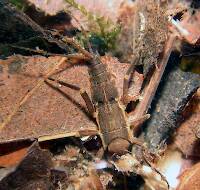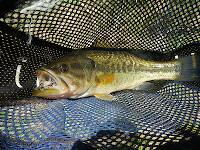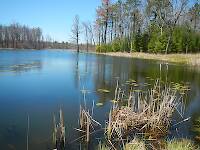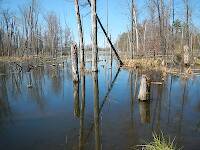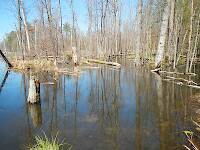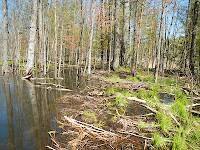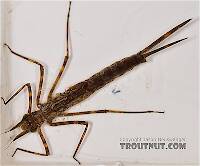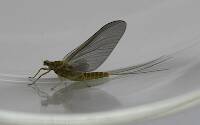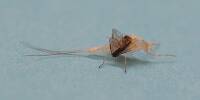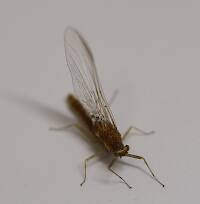
Blue-winged Olives
Baetis
Tiny Baetis mayflies are perhaps the most commonly encountered and imitated by anglers on all American trout streams due to their great abundance, widespread distribution, and trout-friendly emergence habits.
Featured on the forum

This one pretty clearly keys to Kogotus, but it also looks fairly different from specimens I caught in the same creek about a month later in the year. With only one species of the genus known in Washington, I'm not sure about the answer to this ID.

Troutnut is a project started in 2003 by salmonid ecologist Jason "Troutnut" Neuswanger to help anglers and
fly tyers unabashedly embrace the entomological side of the sport. Learn more about Troutnut or
support the project for an enhanced experience here.
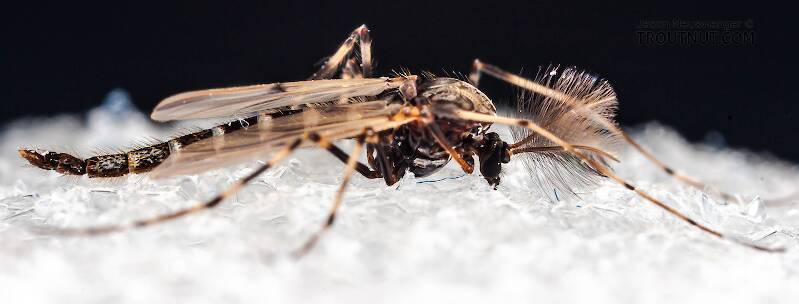
This midge and several like it, including a female I also photographed, hatched from larvae which were living in some fine mud I'm using as substrate in my bug-rearing aquarium.
Troutnut on Apr 10, 2007April 10th, 2007, 10:22 am EDT
I returned from a weekend out of town to find that several midges had emerged from my bug-rearing aquarium. I never specifically put them in it in the first place; apparently, they were embedded in the river silt I used as the substrate for part of it.
I'm pretty sure this one and the other specimen belong to the same species, and I'm guessing the variation in antennae form is a gender difference. It's kinda neat. The antennae on the male seem to be made to be imitated with CDC, except that they're about 100 times too small.
In fact, from the ruler picture, you can see that the whole body of this midge is thinner than a size 18 dry fly hook. I'm not sure how a griffith's gnat is supposed to imitate such a thing.
I'm pretty sure this one and the other specimen belong to the same species, and I'm guessing the variation in antennae form is a gender difference. It's kinda neat. The antennae on the male seem to be made to be imitated with CDC, except that they're about 100 times too small.
In fact, from the ruler picture, you can see that the whole body of this midge is thinner than a size 18 dry fly hook. I'm not sure how a griffith's gnat is supposed to imitate such a thing.
Jason Neuswanger, Ph.D.
Troutnut and salmonid ecologist
Troutnut and salmonid ecologist
Konchu on Apr 10, 2007April 10th, 2007, 11:08 am EDT
Some midges even find their ways onto the backs of unsuspecting mayflies and caddis cases.
What all are you trying to rear?
What sort of aeration are you using?
What all are you trying to rear?
What sort of aeration are you using?
Troutnut on Apr 10, 2007April 10th, 2007, 12:05 pm EDT
I'm trying to rear anything and everything, although I'm having trouble with the mayflies.
At first, I just threw a bunch of them in there, and most of them died from temperature shock (no real surprise, but I thought I'd try). The next time I let them adjust in well-aerated bowls of their own stream water until the temperatures equalized, and I had much better initial survival. Then I went out of town for about four days, came back, and I can only find one mayfly nymph. There are several large, vigorous Limnephilid and Rhyacophila caddis larvae, though. They're doing just fine, and I'm getting suspicious of them.
Most of the bugs go in a regular 5-gallon tank, about half-full, with varied habitat. The aeration all comes from a filter which pumps water up and drops it down through 8 little holes in a rod in different streams. It certainly makes for a lot of bubbles, but some of the bugs have acted oxygen-stressed. I don't know if I could do better with aeration in there or if I'm just limited by the temperature.
I'm having much better survival in the actual artificial stream I built in a 3-inch PVC pipe connected to a 10-gallon tank with a chiller. Nothing has hatched out of it yet (no midge mud was added to the bottom) but fragile species seem to be surviving well. It's a little hard to tell for sure, because I put so much habitat in there they can hide from me pretty easily.
At first, I just threw a bunch of them in there, and most of them died from temperature shock (no real surprise, but I thought I'd try). The next time I let them adjust in well-aerated bowls of their own stream water until the temperatures equalized, and I had much better initial survival. Then I went out of town for about four days, came back, and I can only find one mayfly nymph. There are several large, vigorous Limnephilid and Rhyacophila caddis larvae, though. They're doing just fine, and I'm getting suspicious of them.
Most of the bugs go in a regular 5-gallon tank, about half-full, with varied habitat. The aeration all comes from a filter which pumps water up and drops it down through 8 little holes in a rod in different streams. It certainly makes for a lot of bubbles, but some of the bugs have acted oxygen-stressed. I don't know if I could do better with aeration in there or if I'm just limited by the temperature.
I'm having much better survival in the actual artificial stream I built in a 3-inch PVC pipe connected to a 10-gallon tank with a chiller. Nothing has hatched out of it yet (no midge mud was added to the bottom) but fragile species seem to be surviving well. It's a little hard to tell for sure, because I put so much habitat in there they can hide from me pretty easily.
Jason Neuswanger, Ph.D.
Troutnut and salmonid ecologist
Troutnut and salmonid ecologist
Troutnut on Apr 10, 2007April 10th, 2007, 1:50 pm EDT
In terms of the tank set up, my first thought is that you should set up a flow through system.
That's what I've got the other tank for. :) I would like to have a big glass artificial stream at some point, but I've got a decent low-budget setup now. Current-loving species seem to be doing pretty well in my PVC artificial stream. I was hoping there would be enough water movement for most of them in the (relatively) still tank, too, but maybe it's not going to work.
Jason Neuswanger, Ph.D.
Troutnut and salmonid ecologist
Troutnut and salmonid ecologist
Konchu on Apr 10, 2007April 10th, 2007, 4:39 pm EDT
I have a little bug rearing experience...and keeping the water in the rearing chamber cool is helpful for the health of the less hardy insects. It can't get cold, but cooler temperatures keep oxygen levels a little higher, slow the growth of nasties in the water, and seem to keep the good bugs happier in general. You can suspend the rearing cups over ice or keep them in room A/C. Also, I don't exactly know why, but sometimes the humidity in the air needs to be just right for success once they leave the water.
GONZO on Apr 10, 2007April 10th, 2007, 4:58 pm EDT
I'm not sure how a griffith's gnat is supposed to imitate such a thing.
Schwiebert's theory was that when it was awash in the film, the herl and halo of hackle suggested the loosening pupal shuck around the dark body of the emerging midge. Others have speculated that it imitates a cluster of midges. Both theories are reasonable, I suppose, depending on the size of the Griffith's Gnat that is effective relative to the size of the actual midge. Like many anglers, I just know that it does work. :)
Beachvid on Apr 10, 2007April 10th, 2007, 8:47 pm EDT
As I am sure many of your readers know, the griffith's gnat is suppose to represent a cluster of midges. I don't know for sure if that was the orginal intent of the fly or what anglers decided after the fact. I'm certain some of your fly tying readers know and hopefully will respond.
In some locations at specific times, midges hatch in such large amounts that clusters of adults appear on the surface. At a few locations where midges are extrememly plentiful, the adults get caught in the current seams and end up in an eddy or tailoutin mass quantities.
These are the best pictures I have seen of an adult midge.
In some locations at specific times, midges hatch in such large amounts that clusters of adults appear on the surface. At a few locations where midges are extrememly plentiful, the adults get caught in the current seams and end up in an eddy or tailoutin mass quantities.
These are the best pictures I have seen of an adult midge.
VideoNut
Konchu on Apr 11, 2007April 11th, 2007, 6:09 am EDT
When I started rearing aquatic insects, I killed my share by having the cups of water too close to the ice I used to chill them. Perhaps I didn't allow them to acclimate properly.
But once the insects are acclimated, yes, the water can be very cold. Just so long as it isn't frozen, they'll be OK. I agree that around 10C is a good range of water temp.
But once the insects are acclimated, yes, the water can be very cold. Just so long as it isn't frozen, they'll be OK. I agree that around 10C is a good range of water temp.
Troutnut on Apr 11, 2007April 11th, 2007, 6:40 am EDT
What's your setup with cups and ice, and how often do you have to keep replacing the ice?
One main problem with my current system is that I can't isolate individual bugs; I just throw them in with the rest and hope they come out as adults sooner or later. If the cup & ice thing is easy to set up I'd like to try it.
One main problem with my current system is that I can't isolate individual bugs; I just throw them in with the rest and hope they come out as adults sooner or later. If the cup & ice thing is easy to set up I'd like to try it.
Jason Neuswanger, Ph.D.
Troutnut and salmonid ecologist
Troutnut and salmonid ecologist
Konchu on Apr 11, 2007April 11th, 2007, 3:04 pm EDT
Isolation is important for some of them, especially the prey species.
Ice changes happen whenever I think it gets too warm. Usually, I use the ice for transportation and for the first day or two after they're in the "lab" to give them a chance to settle. Then I just let the ice melt and keep them at a low room temp.
I modified a cooler to hold small resealable bowls over a lower compartment with ice. Ran tubing to an air stone in each bowl. Each bowl had a separate compartment for the adults once they emerged. A lot of work to build.
Ice changes happen whenever I think it gets too warm. Usually, I use the ice for transportation and for the first day or two after they're in the "lab" to give them a chance to settle. Then I just let the ice melt and keep them at a low room temp.
I modified a cooler to hold small resealable bowls over a lower compartment with ice. Ran tubing to an air stone in each bowl. Each bowl had a separate compartment for the adults once they emerged. A lot of work to build.
GONZO on Apr 11, 2007April 11th, 2007, 4:03 pm EDT
Just for what it's worth, Jason, I'll share the methods I used when I wanted Norm Shires to photograph some Drunella (cornuta) for me.
The hatch was already well past in the larger streams, so I traveled to the Poconos to capture some in a small cold headwater where I knew they could still be found (the hatch occurs much later there). After hiking into the stream (and having some great fishing) my wife and I collected a good number of the nymphs and some Pteronarcys stonefly nymphs of multiple year classes. The mayfly and stonefly nymphs, along with sufficient water from the stream, were then placed in separate small plastic aquariums (cheap, from a pet store) that fit inside a large cooler. I used those blue reuseable freeze packs to keep them cool and a battery powered aerator (also cheap, used for minnow buckets) rigged with a "splitter" in the tubing to provide oxygen.
At home, I hooked up a plug-in aeration system and simply replaced the freeze packs in the cooler whenever the water temperature warranted. It was pretty easy to keep the aquaria sub-60 degrees F until Norm was ready to photograph.
The photography of the nymphs went well, but I also hoped to hatch and photograph the duns. Norm transferred the Drunella to a special aquarium he had devised many years ago for just this purpose, but--and this may have been a problem--he used limestone water drawn from the Letort. About a week later he called me to say that nearly all of the nymphs had hatched successfully on the same day, but that none of the duns had escaped the surface of the water in the tank. I rushed over to his house, and there I found nearly the full count of duns--each completely out of its shuck--lying dead on the surface.
I'm still puzzled by what happened to the duns. When I asked Greg Hoover about this, he speculated that they might have been damaged in transport and handling, but I would think that we would have found cripples or a higher number that failed to emerge if this were the reason.
The hatch was already well past in the larger streams, so I traveled to the Poconos to capture some in a small cold headwater where I knew they could still be found (the hatch occurs much later there). After hiking into the stream (and having some great fishing) my wife and I collected a good number of the nymphs and some Pteronarcys stonefly nymphs of multiple year classes. The mayfly and stonefly nymphs, along with sufficient water from the stream, were then placed in separate small plastic aquariums (cheap, from a pet store) that fit inside a large cooler. I used those blue reuseable freeze packs to keep them cool and a battery powered aerator (also cheap, used for minnow buckets) rigged with a "splitter" in the tubing to provide oxygen.
At home, I hooked up a plug-in aeration system and simply replaced the freeze packs in the cooler whenever the water temperature warranted. It was pretty easy to keep the aquaria sub-60 degrees F until Norm was ready to photograph.
The photography of the nymphs went well, but I also hoped to hatch and photograph the duns. Norm transferred the Drunella to a special aquarium he had devised many years ago for just this purpose, but--and this may have been a problem--he used limestone water drawn from the Letort. About a week later he called me to say that nearly all of the nymphs had hatched successfully on the same day, but that none of the duns had escaped the surface of the water in the tank. I rushed over to his house, and there I found nearly the full count of duns--each completely out of its shuck--lying dead on the surface.
I'm still puzzled by what happened to the duns. When I asked Greg Hoover about this, he speculated that they might have been damaged in transport and handling, but I would think that we would have found cripples or a higher number that failed to emerge if this were the reason.
Konchu on Apr 12, 2007April 12th, 2007, 1:30 am EDT
In an artificial environment, the newly winged mayflies have to be able to get away from the water surface. That's why I use a special box attached to the top of the cups. The box is larger than the cup and allows the mayfly to fly away from the water's surface. Many fly away at an angle, so the box must be somewhat larger than the cup and the water level in the cup must be pretty high; otherwise they bounce off the side of the cup and back into the water.
GONZO on Apr 12, 2007April 12th, 2007, 1:57 am EDT
Thanks, Konchu. Norm's aquarium did have a special hinged screen arrangement on top that (I assume) he had used successfully in the past. But, as I recall the water level was rather low, so that might have caused problems. I worried about the rather dramatic change in water chemistry, but only because I know that the fewer things you change, the better the result. We also had a lot of aeration that produced a bubbly surface. I wondered if the lack of a cohesive meniscus might have prevented escape--kind of the way a boat doesn't float well in foaming turbulent water.
Konchu on Apr 12, 2007April 12th, 2007, 3:43 am EDT
Some species actually need the turbulence to help them escape the water's surface.
I should add something to my previous post. Most mayflies need a dry surface that is at least a little rough on which to land after they've come off the water. They'll rest here and make the dun/spinner transition. They need something to hold onto when they molt. Dry paper toweling works well; a fine screen does the same.
I should add something to my previous post. Most mayflies need a dry surface that is at least a little rough on which to land after they've come off the water. They'll rest here and make the dun/spinner transition. They need something to hold onto when they molt. Dry paper toweling works well; a fine screen does the same.
GONZO on Apr 12, 2007April 12th, 2007, 4:05 am EDT
Thanks, Konchu. Your comments about needing something to hang onto in order to molt made me think of another example of reductionist evolution--female white flies (Ephoron). I guess I never thought about it from an evolutionary perspective, but I suppose that the reduction of the legs and the retention of the subimago covering are directly related. Is this viewed as an evolutionary step toward a more advanced form of metamorphosis?
Konchu on Apr 12, 2007April 12th, 2007, 5:08 am EDT
I don't think of most mayflies' legs being reduced, so I doubt the connection.
Note: These remarks are tangential to a discussion on the "maybe tricaudatus" thread.
Note: These remarks are tangential to a discussion on the "maybe tricaudatus" thread.
GONZO on Apr 12, 2007April 12th, 2007, 5:30 am EDT
Sorry, I was only referring to the feeble non-functional legs of adult Ephoron females and that the white fly females don't molt out of their dun covering prior to mating and egg-laying. I didn't mean to imply mayflies as a group. I guess what I'm really asking is whether Ephoron is considered to be a less primitive genus within the Ephemeroptera.
Konchu on May 15, 2007May 15th, 2007, 10:58 am EDT
Thought I'd add something from recent experience:
Some species need a partially submerged stick in the water so that they can crawl out to molt. Also, some stones or other native substrate is helpful.
Some species need a partially submerged stick in the water so that they can crawl out to molt. Also, some stones or other native substrate is helpful.
Len on Jan 17, 2008January 17th, 2008, 11:50 pm EST
The genus of this chironomid adult is Stictochironomus.
Troutnut on Jan 20, 2008January 20th, 2008, 10:03 pm EST
Thanks, Len!
Jason Neuswanger, Ph.D.
Troutnut and salmonid ecologist
Troutnut and salmonid ecologist
Quick Reply
Related Discussions
Topic
Replies
Last Reply
4
Apr 12, 2014
by Brookyman
by Brookyman




